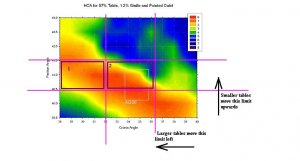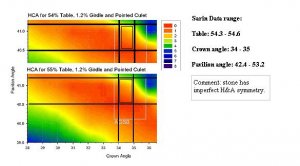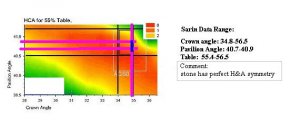- Joined
- Apr 3, 2004
- Messages
- 33,852
pav angles of less than 41 degrees or just the average of less than 41 degrees? Some of these range between the max and the min is pretty wide. Same with the crown angle.









----------------
On 5/2/2004 11:29:57 AM strmrdr wrote:
If one facet is off it will usualy show in the images and it is fun to track it down and compare the measurements to the images.
Even more fun is to start off with an almost h&a image and trace back to the sarin report to figure out why its almost h&a and what facet is responsible for the 'defect' in the image :}
Even more challenging is take a b-scope triple vh diamond compared to say a 2h 1vh diamond and try and figure out the differences based on the sarin data.
When doing all this you have to keep in mind however that the sarin has a margin of errer so its never a precise exercise but you can often track down the larger differences. :}
----------------

